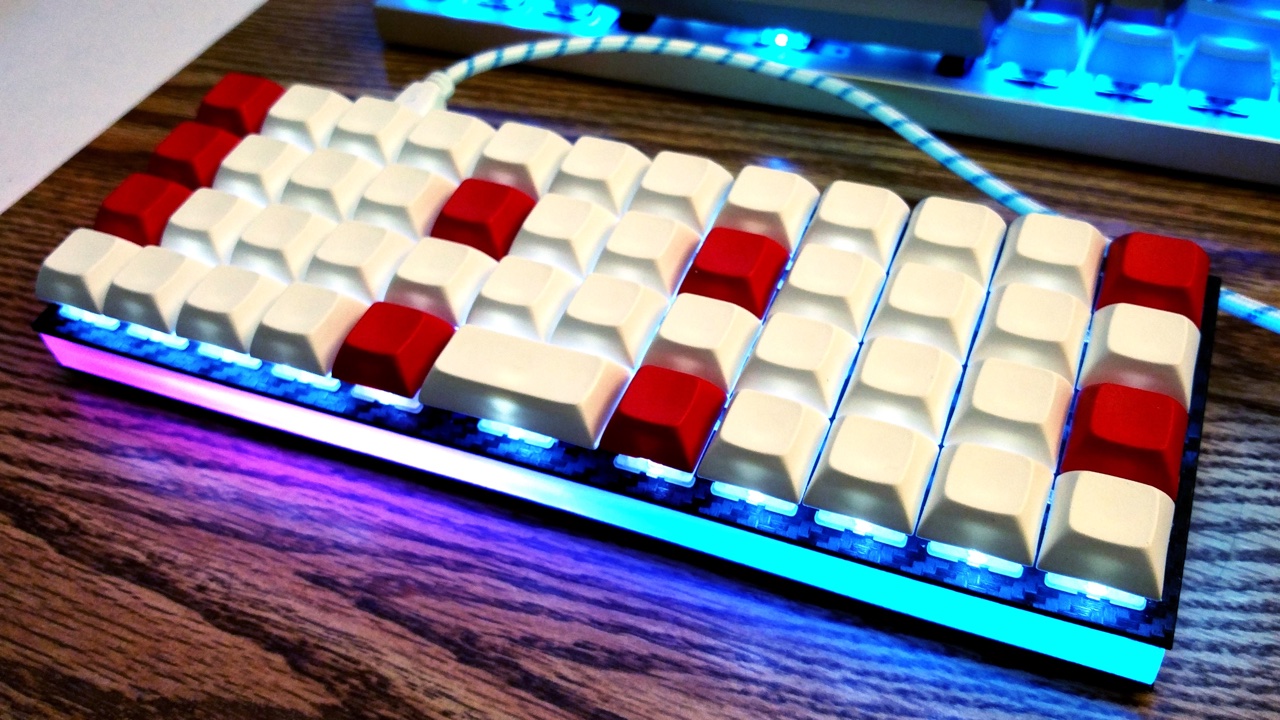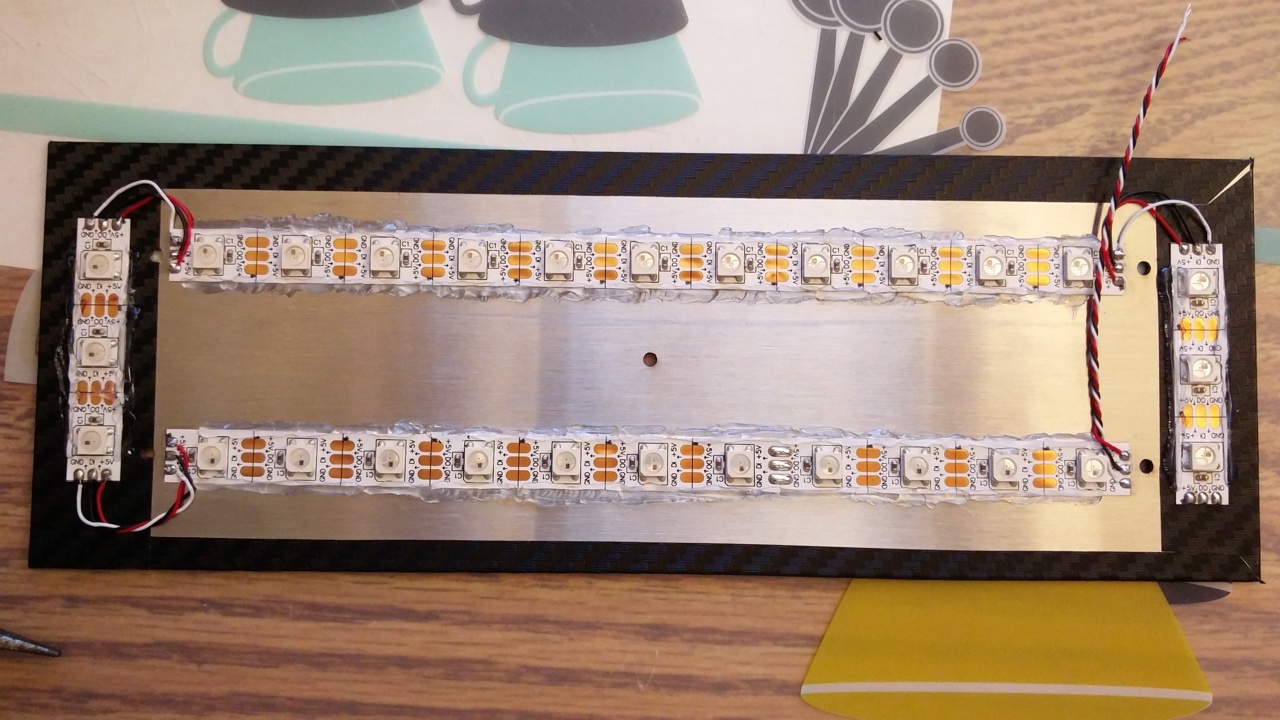+[](https://travis-ci.org/jackhumbert/qmk_firmware)
# Quantum Mechanical Keyboard Firmware
This is a keyboard firmware based on the [tmk_keyboard firmware](http://github.com/tmk/tmk_keyboard) with some useful features for Atmel AVR controllers, and more specifically, the [OLKB product line](http://olkb.co), the [ErgoDox EZ](http://www.ergodox-ez.com) keyboard, and the [Clueboard product line](http://clueboard.co/).
This is not a tiny project. While this is the main Readme, there are many other files you might want to consult. Here are some points of interest:
-* The Readme for your own keyboard: This is found under `keyboards/<your keyboards's name>/'. So for the ErgoDox EZ, it's [here](/tree/master/keyboard/ergodox_ez/); for the Atomic, it's [here](/tree/master/keyboard/atomic/) and so on.
-* The [build guide](BUILD_GUIDE.md), also mentioned in the next section. This is how you put your development environment together so you can compile the firmware.
+* The Readme for your own keyboard: This is found under `keyboards/<your keyboards's name>/`. So for the ErgoDox EZ, it's [here](keyboards/ergodox_ez/); for the Atomic, it's [here](keyboards/atomic/) and so on.
+* The [build guide](doc/BUILD_GUIDE.md), also mentioned in the next section. This is how you put your development environment together so you can compile the firmware.
* The list of possible keycodes you can use in your keymap is actually spread out in a few different places:
- * [tmk_core/common/keycode.h](/blob/master/tmk_core/common/keycode.h) - the base TMK keycodes. This is the actual source file.
- * [tmk_core/doc/keycode.txt](/blob/master/tmk_core/doc/keycode.txt) - an explanation of those same keycodes.
- * [quantum/keymap_common.h](/blob/master/quantum/keymap_common.h) - this is where the QMK-specific aliases are all set up. Things like the Hyper and Meh key, the Leader key, and all of the other QMK innovations. These are also explained and documented below, but `keymap_common.h` is where they're actually defined.
-* The [TMK documentation](/tree/master/tmk_core/doc). QMK is based on TMK, and this explains how it works internally.
+ * [tmk_core/common/keycode.h](tmk_core/common/keycode.h) - the base TMK keycodes. This is the actual source file.
+ * [doc/keycode.txt](doc/keycode.txt) - an explanation of those same keycodes.
+ * [quantum/keymap_common.h](quantum/keymap_common.h) - this is where the QMK-specific aliases are all set up. Things like the Hyper and Meh key, the Leader key, and all of the other QMK innovations. These are also explained and documented below, but `keymap_common.h` is where they're actually defined.
+* The [TMK documentation](doc/TMK_README.md). QMK is based on TMK, and this explains how it works internally.
## Getting started
-* [BUILD_GUIDE.md](BUILD_GUIDE.md) contains instructions to set up a build environment, build the firmware, and deploy it to a keyboard. Once your build environment has been set up, all `make` commands to actually build the firmware must be run from a folder in `keyboard/`.
-* If you're looking to customize a keyboard that currently runs QMK or TMK, find your keyboard's directory under `keyboard/` and run the make commands from there.
-* If you're looking to apply this firmware to an entirely new hardware project (a new kind of keyboard), you can create your own Quantum-based project by using `./new_project.sh <project_name>`, which will create `/keyboard/<project_name>` with all the necessary components for a Quantum project.
+* [BUILD_GUIDE.md](doc/BUILD_GUIDE.md) contains instructions to set up a build environment, build the firmware, and deploy it to a keyboard. Once your build environment has been set up, all `make` commands to actually build the firmware must be run from a folder in `keyboards/`.
+* If you're looking to customize a keyboard that currently runs QMK or TMK, find your keyboard's directory under `keyboards/` and run the make commands from there.
+* If you're looking to apply this firmware to an entirely new hardware project (a new kind of keyboard), you can create your own Quantum-based project by using `util/new_project.sh <project_name>`, which will create `/keyboards/<project_name>` with all the necessary components for a Quantum project.
### Makefile Options
### Customizing Makefile options on a per-keymap basis
-If your keymap directory has a file called `makefile.mk` (note the lowercase filename, and the `.mk` extension), any Makefile options you set in that file will take precedence over other Makefile options (those set for Quantum as a whole or for your particular keyboard).
+If your keymap directory has a file called `Makefile` (note the filename), any Makefile options you set in that file will take precedence over other Makefile options (those set for Quantum as a whole or for your particular keyboard).
-So let's say your keyboard's makefile has `CONSOLE_ENABLE = yes` (or maybe doesn't even list the `CONSOLE_ENABLE` option, which would cause it to revert to the global Quantum default). You want your particular keymap to not have the debug console, so you make a file called `makefile.mk` and specify `CONSOLE_ENABLE = no`.
+So let's say your keyboard's makefile has `CONSOLE_ENABLE = yes` (or maybe doesn't even list the `CONSOLE_ENABLE` option, which would cause it to revert to the global Quantum default). You want your particular keymap to not have the debug console, so you make a file called `Makefile` and specify `CONSOLE_ENABLE = no`.
### Customizing config.h on a per-keymap basis
-If you use the ErgoDox EZ, you can make a `config_user.h` file in your keymap directory and use it to override any `config.h` settings you don't like. Anything you set there will take precedence over the global `config.h` for the ErgoDox EZ. To see an example of this, check out `keymaps/erez_experimental`.
+You can also make a `config.h` file in your keymap directory and use it to override any `config.h` settings you don't like. Anything you set there will take precedence over the global `config.h` for the ErgoDox EZ. To see an example of this, check out `keymaps/erez_experimental`.
## Quick aliases to common actions
To use it, use `KC_LSPO` (Left Shift, Parens Open) for your left Shift on your keymap, and `KC_RSPC` (Right Shift, Parens Close) for your right Shift.
-The only other thing you're going to want to do is create a `makefile.mk` in your keymap directory and set the following:
+It's defaulted to work on US keyboards, but if your layout uses different keys for parenthesis, you can define those in your `config.h` like this:
+
+ #define LSPO_KEY KC_9
+ #define RSPC_KEY KC_0
+
+The only other thing you're going to want to do is create a `Makefile` in your keymap directory and set the following:
```
COMMAND_ENABLE = no # Commands for debug and configuration
}
```
-As you can see, you have three function. you can use - `SEQ_ONE_KEY` for single-key sequences (Leader followed by just one key), and `SEQ_TWO_KEYS` and `SEQ_THREE_.EYS` for longer sequences. Each of these accepts one or more keycodes as arguments. This is an important point: You can use keycodes from **any layer on your keyboard**. That layer would need to be active for the leader macro to fire, obviously.
+As you can see, you have three function. you can use - `SEQ_ONE_KEY` for single-key sequences (Leader followed by just one key), and `SEQ_TWO_KEYS` and `SEQ_THREE_KEYS` for longer sequences. Each of these accepts one or more keycodes as arguments. This is an important point: You can use keycodes from **any layer on your keyboard**. That layer would need to be active for the leader macro to fire, obviously.
### Temporarily setting the default layer
### Remember: These are just aliases
-These functions work the same way that their `ACTION_*` functions do - they're just quick aliases. To dig into all of the tmk ACTION_* functions, please see the [TMK documentation](https://github.com/jackhumbert/qmk_firmware/blob/master/tmk_core/doc/keymap.md#2-action).
+These functions work the same way that their `ACTION_*` functions do - they're just quick aliases. To dig into all of the tmk ACTION_* functions, please see the [TMK documentation](https://github.com/jackhumbert/qmk_firmware/blob/master/doc/keymap.md#2-action).
Instead of using `FNx` when defining `ACTION_*` functions, you can use `F(x)` - the benefit here is being able to use more than 32 function actions (up to 4096), if you happen to need them.
#define EXT_PLV M(13)
```
-As was done on the [Planck default keymap](/keyboard/planck/keymaps/default/keymap.c#L33-L40)
+As was done on the [Planck default keymap](/keyboards/planck/keymaps/default/keymap.c#L33-L40)
#### Timer functionality
Your keyboard can make sounds! If you've got a Planck, Preonic, or basically any keyboard that allows access to the C6 port, you can hook up a simple speaker and have it beep. You can use those beeps to indicate layer transitions, modifiers, special keys, or just to play some funky 8bit tunes.
-The audio code lives in [quantum/audio/audio.h](/quantum/audio/audio.h) and in the other files in the audio directory. It's enabled by default on the Planck [stock keymap](/keyboard/planck/keymaps/default/keymap.c). Here are the important bits:
+The audio code lives in [quantum/audio/audio.h](/quantum/audio/audio.h) and in the other files in the audio directory. It's enabled by default on the Planck [stock keymap](/keyboards/planck/keymaps/default/keymap.c). Here are the important bits:
```
#include "audio.h"
## RGB Under Glow Mod
-
+
Here is a quick demo on Youtube (with NPKC KC60) (https://www.youtube.com/watch?v=VKrpPAHlisY).
#define ws2812_DDRREG DDRB
#define ws2812_pin PB3
-The firmware supports 5 different light effects, and the color (hue, saturation, brightness) can be customized in most effects. To control the underglow, you need to modify your keymap file to assign those functions to some keys/key combinations. For details, please check this keymap. `keyboard/planck/keymaps/yang/keymap.c`
+The firmware supports 5 different light effects, and the color (hue, saturation, brightness) can be customized in most effects. To control the underglow, you need to modify your keymap file to assign those functions to some keys/key combinations. For details, please check this keymap. `keyboards/planck/keymaps/yang/keymap.c`
### WS2812 Wiring
-
+
Please note the USB port can only supply a limited amount of power to the keyboard (500mA by standard, however, modern computer and most usb hubs can provide 700+mA.). According to the data of NeoPixel from Adafruit, 30 WS2812 LEDs require a 5V 1A power supply, LEDs used in this mod should not more than 20.